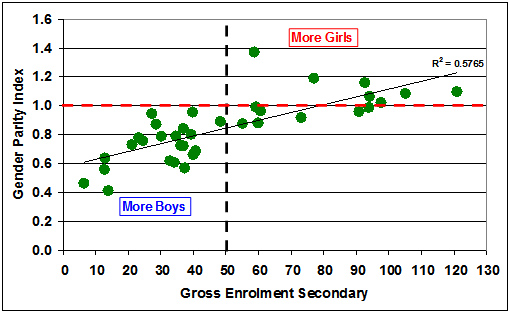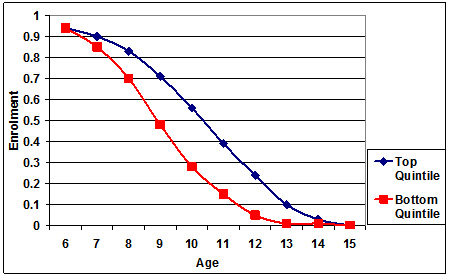Equity and Participation
Equity in access to education remains elusive. Participation and progression remains strongly associated with household wealth despite commitments to pro-poor policies and investment of resources. Inequity manifests itself in many ways. Socio-economic status is strongly associated with lower probabilities of ever enrolling, progressing through grades at appropriate ages, reaching levels of achievement necessary to complete schooling successfully, and with subsequent access to labour markets that can provide secure incomes. Regional disparities remain striking and in many African countries and in India characteristically the north, but occasionally the south’ of many countries remains underdeveloped with wide disparities in the quantity and quality of schooling. Urban rural differences persist and are increasingly accompanied by intra-urban differences associated with migration and the development of slums and temporary settlements poorly served by educational infrastructure.
Gendered patterns of exclusion are widespread but have been changing. Gaps in overall participation have been closing in many countries as enrolment rates rise. Participation in secondary schooling tends to favour boys in much of Sub Saharan Africa and South Asia, not least because boys tend to persist in education longer to older ages. Most countries that enrol more than half of their children in secondary schools have more girls than boys enrolled suggesting that in low enrolment countries discrimination against girls may be more marked. Other exclusions that have an impact on equity include those related to social group, ethnicity, caste, language, disability, orphanhood, civil status, and religion.
Gender Parity and Secondary Enrolment Rates in SSA

CREATE has explored Evidence from 13 sub-Saharan African countries using national data from the 1990s and 2000s to compare patterns fo enrolment over time. This analysis shows that though overall participation has increased, the chances of the children from the poorest households enrolling and progressing through school relative to the richest households have generally not improved substantially. In some case they have deteriorated. Reductions in the number of children out of school have occurred but this has often been accompanied by an increase in the proportion of children over age for the grade in which they are enrolled.
Poorer children are more likely to be over age and unlikely to complete schooling especially if they are girls. Girls are more likely to be out of school than boys in most of the Francophone countries but not in most of the Anglophone countries. Rural children remain more likely to be overage (Lewin and Sabates, 2011).
Data from Bangladesh show that inequalities have also persisted in access to education with the poorest being excluded in greater proportions in all the zones of exclusion (Hossain and Zeitlyn, 2010). Most urban dwellers have more assets and are less likely to suffer food insecurity. However, the lack of public schools to service urban slums and the inability of the urban poor to afford private providers means that they are often completely excluded (Cameron, 2010).
In India, relatively poor access indicators for Muslims (Härmä, 2010), low castes, tribal groups (Sedwal and Kamat, 2008) and girls (Bandyopadhyay and Subrahmanian, 2008) show the powerful effects of social exclusion. Regional disparities in India also mean that some states are doing well while other lag behind (Lewin, 2011b) and even within states, remote areas or regions inhabited by minority groups may be poorly served by education infrastructure (Govinda and Bandyopadhyay, 2010a). Poorer households, and those from scheduled castes and tribes tend to enter school later. This reduces the chances of chidren reaching secondary school grades.
Chances of Entering Secondary School by Age of Entry in India

In Ghana 10% of the secondary schools produce nearly 80% of all science and engineering undergraduates. Less than 3% of those qualified for degree programmes originate from the lowest scoring 40% of all secondary schools. In South Africa data analysis shows that over 30% of a national sample of Grade 4 children are more than two years over age and that the older the child is the lower the score on numeracy and literacy tests (Taylor et al 2011). Overage children are more likely to be from poor households and receive social grants.
The messages from the research are clear. Though there has been progress in more participation, it falls far short of the gains that were anticipated. Universal access requires greater equity to close the gap between the poorest and other households.